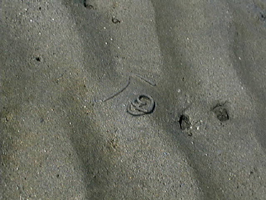 |
 |
 |
 |
The sediment surface across False Bay shows a great deal
of variety. Differences in the physical appearance of parts of the bay
are a good clue to different underlying biological communities.
1) Find a sandy area of the bay in which there are burrows exposed at the surface.
3) Count all of the burrows/tubes of each type in your marked area. (You donāt need to know the associated organism yet.
4) Use a shovel to dig up the top 10 ö 20 cm of sediment within part of your area, and sieve the sand through a 1 or 2 mm sieve. You will want to use a pool of water to help sieve the sand. Repeat this four times, identifying and counting the organisms as you go.
5) Use carefully directed digging to figure out
(if possible) which organisms really go with which burrows. Use tables
to record your observations, such as the following:
| Location: | ||
|
|
|
|
| Organism | Number |
Questions:
1) What correspondences can you find between your
burrow counts and your organism counts?
2) After trying transects and sieving in several
localities, do you think that surface observations would provide you with
a non-invasive way of observing different habitats in the bay? That is,
could this become a "remote sensing" technique?
3) Are there many organisms that do not leave a
trace at the surface?
1) Use the following checklist to have participants characterize what they find while looking through the Ulva area on the west side of the bay.
SPECIES CHECKLIST:
________ Hemigrapsus
________ Terebellid
Where is its tube found? __________________________
What commensal organism is found with the Terebellid?
__________________________
________ Amphipods
________ Epiactus
________ Tanaid
________ Lacuna
________ Maldanid (Bamboo Worm)
________ Nemertean
Which species is it? _________________________
ACTIVITIES CHECKLIST:
Stick your finger on top of the Ulva and then
within the layers of Ulva. What differences do you observe?
______________________________________________________
Look closely at the individual pieces of Ulva. Can you find any evidence of the Ulva being eaten? What organisms might be feeding on it? ______________________________________________________
False Bay is a diverse environment. A sense of the place can only be gained by going out and walking the bay. As you do so, look for and/or experience the following:
SPECIES CHECKLIST:
________ Dendraster (Sand Dollar)
How is it oriented in the sand? _____________________________
________ Bubble Snail
In what specific habitat are these found? _____________________
Look closely for egg masses. What are they attached
to? ____________________________
________ Gaper Clam
How did it get its name? _________________________________
________ Anthopleura (anemone)
What is it attached to? __________________________________
________ Clinocardium (Heart Cockle)
________ Macoma nasuta (Bent-nosed Clam)
________ Macoma inquinata (Regular Clam)
________ Polychaetes
List five families that you see. _____________________________
________ Dolly the dog
________ Hermit Crab
________ Leptosynapta clarki (sea
cucumber)
________ Upogebia (mud shrimp)
ACTIVITES CHECKLIST:
* Find a scavenger and name it. _______________
* Find two burrows, holes, or other surface features different from those you observed while doing the transect. Give a brief description of the burrow and what organism likely lives there.
* Find a burrow large enough to stick your finger
in.
What does the burrowing lining feel like? _________________________
How is the water temperature different? ___________________________
* Look for various tracks in the sand. List
three that you find. Can you tell why the
organism was there?
Track #1: ___________________________________
Track #2: ___________________________________
Track #3: ___________________________________
* Find a mobile organism. Imagine you were this organism. What might happen at high tide? Would you be able to tell the difference between tide pools and areas that go dry? What kinds of signals might you look for so that youíre not stranded when the tide goes out? _____________________________________________________________________
* In two different areas, take off a shoe and stick your foot into the sand/mud. What does this tell you about the sediment composition of the area? ___________________
* Find the tell-tale tracks of a predator. Can you tell what it was it eating? _____________________________________________________________________
* Estimate the number of polychaetes in False Bay. ____________________________
OTHER FALSE BAY EXPERIENCES (EXTRA CREDIT):
________ Throw a shovel, with the blade end landing in
the sand. Does your success depend on the sediment type?
________ Catch (and release) a sculpin.
________ Throw a clam or cockle for Dolly the dog.